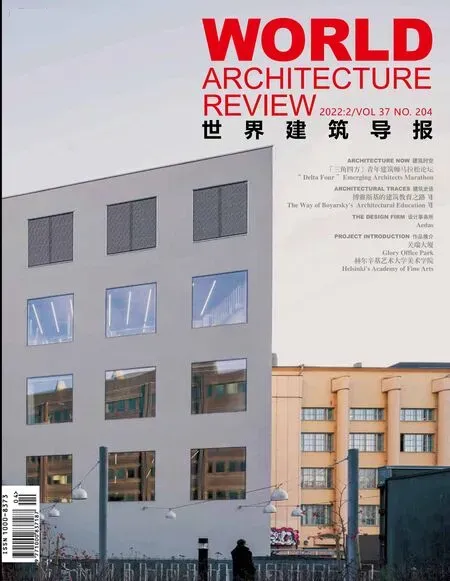橫琴國際金融中心中國珠海
服務范圍:設計及項目建筑師
業主:珠海華發城市運營投資控股有限公司(珠海十字門
中央商務區建設控股有限公司)
建筑面積:218 955平方米(地上:138 158平方米;
地下:80 797平方米)
竣工年份:2020年
主要設計人:溫子先博士,全球設計董事;
紀達夫,主席及全球設計董事
攝影:CreatAR Images; Terrence Zhang
Architect: Aedas
Client: Zhuhai Shizimen Central Business District Development Holdings Co., Ltd
Gross Floor Area: 218 955 sq m (above ground: 138 158 sqm;
below ground: 80 797 sqm)
Completion Year: 2020
Design Directors: Dr. Andy Wen, Global Design Principal;
Keith Griffiths, Chairman and Global Design Principal
Photography: CreatAR Images; Terrence Zhang
珠澳第一高樓,以蛟龍出海打造中國新力量
“有如蛟龍卷滄海,怒氣直欲山前吞。”一座339米高的建筑毗鄰珠江與南海的交匯口岸,蜿蜒盤旋拔地而起,塔樓一分為四,猶如四條蛟龍沖破藩籬,直沖云霄,盤旋升騰間,俯視整片水域。這座將“蛟龍出海”的神話場景完美再現的超高層,正是Aedas最新打造的珠海橫琴國際金融中心。
自《粵港澳大灣區發展規劃綱要》發布后,三個重要極點城市之一的珠海,成為了未來規劃發展的重點。而橫琴作為珠海乃至大灣區中唯一與港澳陸路相連的國家級戰略新區,憑借獨有的區位優勢,正在崛起成為大灣區發展的重要引擎。同時,作為對外“一帶一路”開放發展的前沿陣地,也對自貿時代提供著有力支持。該項目正位于未來金融新區橫琴島,東連港澳、西通粵西、北靠珠三角、南依橫琴,是珠海與澳門之間十字形貫通水域的中心點。“我們想要在這個蘊藏巨大能量的地塊,打造一棟特別的建筑,來象征金融新區的新生,代表興旺發展的橫琴,甚至傳遞出新時代的中國力量。” Aedas全球設計董事溫子先博士(Dr. Andy Wen)如是說。項目集甲級辦公、會議展覽、商務公寓和商業零售等功能于一體。設計將商業零售和會議中心在便于出入的裙房,甲級辦公空間放于中低層,商務公寓置于靜謐的高層。
設計充分利用地塊山海之間的環境優勢,選取寓意著新生力量的“蛟龍出海”為主題,并從中國古典繪畫經典南宋陳容《九龍圖》中汲取建筑體量靈感,以蜿蜒靈動的裙樓線條詮釋巨龍盤旋,簡潔有力的塔樓線條展現破水而出的大氣磅礴,在氣勢逼人的建筑形態中,與不遠處的海面相呼應,共同喚起人們對“蛟龍出海”的想象。塔樓的四個部分由裙樓的外側體塊噴薄而出,象征著橫琴匯集了珠海、澳門、香港和深圳的城市精華,將其融合為一,成為珠江口超級大都會的一顆明珠。
由于珠海時間較長的臺風季,建筑采用流線造型以降低塔樓風荷載,并精心考量建筑坐向和裙房開口朝向,有效降低風阻,減少陣風,提高行人區的舒適性。幕墻玻璃與金屬面板流瀉而下,成為隨風飄動的巨大幕簾,覆蓋裙房中高挑的展廳,塑造出極具識別性的入口雨棚。為更好地呈現塔樓向裙樓的自然過渡,設計將體量沿中心軸和水平軸空間扭轉,使裙樓的屋頂得以延展升騰為塔樓外墻,從而將高聳窄長的塔樓與相對寬闊低矮的裙樓完美結合,線條靈動優雅。
“建筑不只是自由的藝術表達,更應是現實中可落地的方案。”團隊通過數字化工具,運用參數化技術將幕墻劃分為多個小型基礎單元,嚴格計算板塊尺寸,盡可能減少尺寸種類數量,并通過控制設計實現曲線的平滑過渡。
在裙樓和塔樓的轉換區,通過調整百葉固定件的角度變化,在不產生曲面百葉的前提下實現立面線條的自然流轉;裙樓的線條通過合理化拆分的方式,以一段段直線百葉趨近扭曲百葉。最終以平板玻璃為主搭配少量單曲面玻璃完美呈現了3D曲線,在高精度實現設計的同時,最大程度降低建筑成本和建造難度。
Zhuhai's tallest building - an emerging power from the sea
Aedas has recently completed the iconic 339-metres Hengqin International Financial Centre tower, which stands at the estuary of the Pearl River and overlooking Macau just across the waters. The spirally rising volume invokes the Chinese myth of flood dragons emerging from the sea - a perfect metaphor for the strength and power of the region.
The project is located in Zhuhai’s Hengqin Island, a future financial district connecting Hong Kong, Macao and other major cities in the Greater Bay Area. The city, surrounded by the sea and mountainous terrain and positioned at the heart of this world-class city cluster, is thriving to become a driving force of growth highlighted in China’s latest national development strategies.
“The site possesses powerful momentum for future developments. So we imagined this unique building to express the quality of speed, growth and vitality. It resembles prosperity of the new district and rise of the country,” explains Dr Andy Wen, Aedas Global Design Principal. The development comprises mixed programs including Grade-A office, conference and exhibition amenities, commercial apartments and retail space. Conventional and retail spaces are placed in the podium to allow for easy access. Offices are up to the middle of the tower while the apartments are set on top, enjoying the tranquil and scenic sea views.
Inspired by "The Nine Dragons", a famous stroll of Chinese painting from the Song Dynasty,the design embodies the convergence of energy in the architectural form. The traditional totem of the dragon emerging from the sea symbolises new life breaking through the barriers and ceaselessly flourishing into an imposing power. It’s transformed into the elegant curves and powerful twists of the tower, complementing the undulating surface of the waters around it. With four vertical blocks shooting up to the sky and merging into the building, the tower itself also becomes a symbol of talents and resources congregating at Hengqin to create a new metropolis in the Greater Bay Area.
The subtropical climate of Zhuhai imposes higher requirements on the tower’s wind load to withstand the strong winds during typhoon seasons. The design team meticulously adjusted the building’s orientation and entrance to reduce wind drag and improve pedestrians’ experience.
The fluid elevations are clad in glass and metal panels, pouring down to form a huge curtain swept aside and twisted in the cosmic wind ending in a flurry of horizontally creased envelop surrounding a tall exhibition space and a unique canopy over the entrance. A smooth transition between the super high-rise and the low rise podium is achieved by pulling and twisting the vertical elements around the central axis, turning the tower walls into the podium roof.
“Architecture is not just an artistic expression. It should also be buildable solutions.”Parametric techniques were applied to design the details of the curvy curtain wall. With rigorous calculations, the curtain wall is divided into smaller, standardised units in a limited numbers of dimensional types. The glass panel units, mostly flat, are installed by sections and with gradually shifting angles to form the three-dimensional curve. The design team is thus able to realise the design with highest precision and minimised construction cost.










